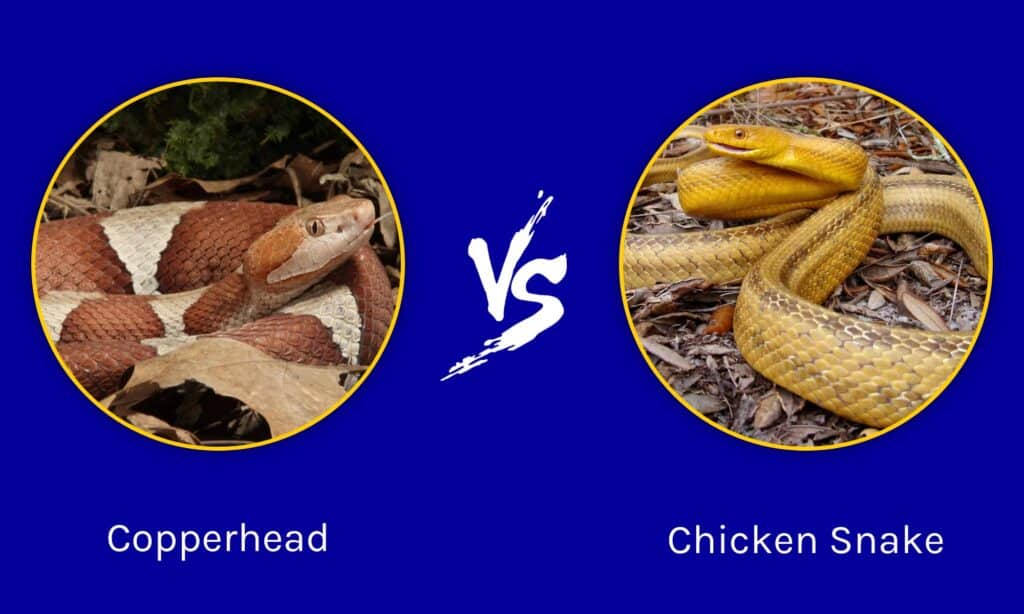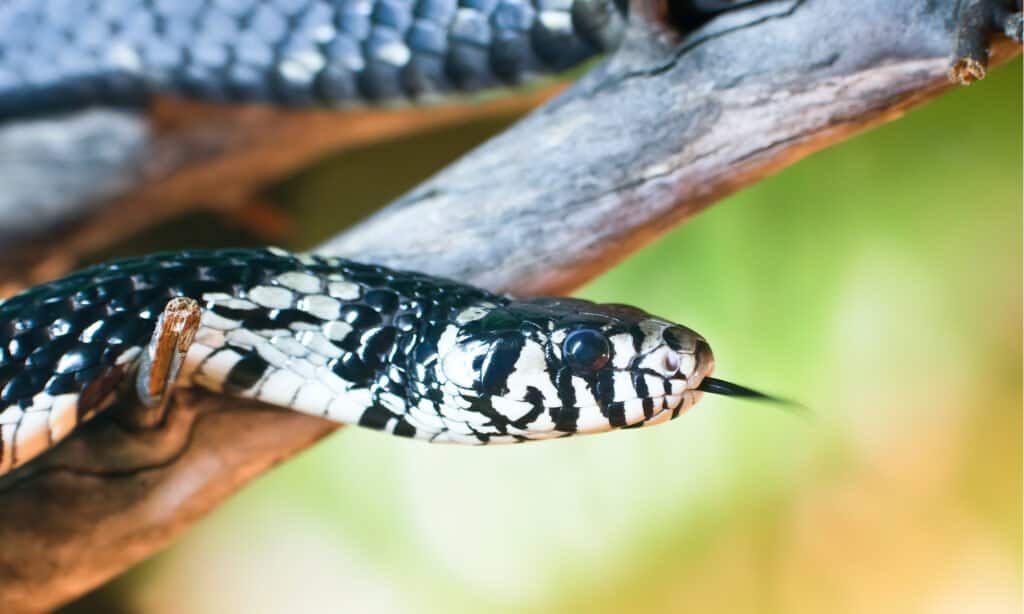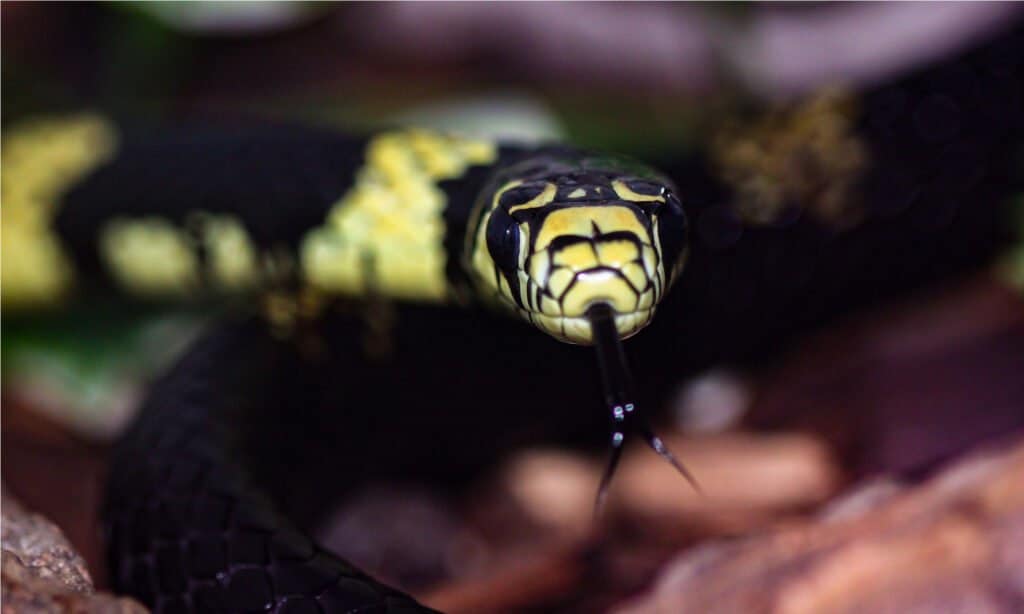The copperhead and chicken snake are two snake species you’re probably familiar with. Although the “chicken snake” is not scientifically recognized by that name, the species was given the name based on its love for chickens as prey. Also known as the caninana snake, chicken snakes are found in the warmer parts of the Americas, while copperheads are found in the southeastern United States.
Like most snakes, these species have fascinating similarities and differences. If you’ve ever wondered about the major differences and similarities between copperheads and chicken snakes, this article has all you need to know. Let’s compare and contrast the copperhead and the chicken snake.
Comparing the Copperhead and the Chicken Snake

| Copperhead | Chicken Snake | |
|---|---|---|
| Venomous? | Yes | No |
| Size | 0.2 – 0.7 pounds 20-37 inches | 8 – 10 pounds 48– 96 inches |
| Morphology | Copper or orange-red triangular heads Pale brown to pinkish-brown skin Hourglass-shaped markings that are colored copper to reddish-brown Dorsal and ventral scales Juveniles have bright-colored tail tips | Black with yellow spots that may form crossbands Yellow-tipped snout |
| Habitats | Deciduous forest, rock outcroppings, mixed woodlands, and occasionally swampy regions | Forested areas and often found near water bodies |
| Mode of defense/ attack | Venomous bites Musk | Constriction |
| Diet | Toads, small mammals, frogs, lizards, rats, small snakes, and even other copperheads | Chickens, small mammals, lizards, birds, and other snakes |
| Temperament | They freeze when humans come near, and this causes people to unknowingly step on/near them and get bitten. | Mildly aggressive |
Key Differences Between the Copperhead and the Chicken Snake
The main differences between copperheads and chicken snakes lie in their morphology, snake families, diet, habitats, and modes of attack and defense. One similarity they have is that they are both solitary except during mating season. Let’s address their differences in detail.
Copperhead vs. Chicken Snake: Morphology

Copperheads are shorter than chicken snakes.
©Dennis W Donohue/Shutterstock.com
Chicken snakes and copperheads do not look alike, with chicken snakes being much longer and heavier than copperheads. Copperheads measure 20-37 inches (1.7 to 3.1 feet) on average, while chicken snakes measure 48– 96 inches (4 to 8 feet), which makes chicken snakes close to double their length. Weight-wise, chicken snakes take the lead again, measuring 128- 160 ounces compared to copperheads, which weigh 3.2 – 11.2 ounces.
Copperheads can easily be identified by their copper-colored heads on their pale brown to pinkish-brown skins with copper to reddish-brown hourglass-shaped markings. Chicken snakes are black with yellow spots that may form crossbands. They also have snouts with yellow tips.
Copperhead vs. Chicken Snake: Snake Family and Diet

Chicken snakes are constrictors known for their love of chickens.
©eans/Shutterstock.com
Copperheads and chicken snakes come from two different snake families. Copperheads are pit vipers and use their pit organs to sense and detect prey through their body heat, making them formidable hunters. They ambush their prey once they get close enough by digging into their skins with their long solenoglyphous fangs, which inject venom into their prey.
While the venom spreads and weakens their prey, copperheads may or may not hold on to them until they are weak enough to be consumed. They feed on toads, small mammals, frogs, lizards, rats, small snakes, and even other copperheads, making them cannibals.
On the other hand, chicken snakes are colubrids and constrictors. They wrap their long bodies around their prey and suffocate them to death. As their prey exhales, constrictors squeeze more tightly, soon killing them. Chicken snakes are known for their love of chickens as meals, but they also eat other small mammals, lizards, birds, and other snakes. However, they do not eat other chicken snakes.
Copperhead vs. Chicken Snake: Habitats
Copperheads and chicken snakes are found in different habitats. Copperheads inhabit a wide range of habitats and can be found in forests where most trees lose their leaves in the fall. They can also be found in rock outcroppings, mixed woodlands, swampy regions, and even abandoned buildings, so be sure to look out for them in your old shed if they are found in your state.
Chicken snakes, however, can be found in forested areas and are often found near water. A mostly arboreal species, they are most likely found in the trees. It’s also important to note that chicken snakes inhabit Central and South America, while copperheads only occur in the southeastern United States.
Copperhead vs. Chicken Snake: Modes of Attack and Defense
Copperheads are venomous snakes, while chicken snakes are constrictors. Copperheads have hemotoxic venom but aren’t considered extremely venomous. This isn’t to say that their bites are not capable of killing a human- they are. However, they have a relatively low venom yield, especially compared to their lethal venom dose.
These pit vipers have a maximum venom yield of 80 to 100mg and need about 85 to 100mg to kill a human. On average, they only emit 26 mg of venom, which is why only about 0.01% of their bites are fatal. Copperheads also have the ability to spray foul-smelling musk, which mostly occurs when they are picked up or touched.
Chicken snakes are constrictors. Their long, thick bodies give them enough strength to kill their prey through suffocation.
Copperhead vs. Chicken Snake: Temperament

Chicken snakes are more aggressive than copperheads.
©gabriel_viniciuss/Shutterstock.com
Copperheads and chicken snakes have two different reputations with humans. While copperheads aren’t known to be aggressive, they bite more people than any other snake in the USA. How does this happen? Copperheads freeze in a spot in a bid to camouflage when they sense humans. This often backfires as humans do not spot them and proceed to walk on or near them. This causes copperheads to bite. However, unless provoked, these pit vipers aren’t known to attack.
The same cannot be said of chicken snakes, which seem to have mixed impressions on people. Many people claim that these snakes are aggressive and will chase and bite with little provocation, unlike most snakes that only attack as a last resort. However, other reports dispute this and claim that they are highly defensive, but only when directly provoked.
The photo featured at the top of this post is © imageBROKER.com/Shutterstock.com
Discover the "Monster" Snake 5X Bigger than an Anaconda
Every day A-Z Animals sends out some of the most incredible facts in the world from our free newsletter. Want to discover the 10 most beautiful snakes in the world, a "snake island" where you're never more than 3 feet from danger, or a "monster" snake 5X larger than an anaconda? Then sign up right now and you'll start receiving our daily newsletter absolutely free.
Thank you for reading! Have some feedback for us? Contact the AZ Animals editorial team.






